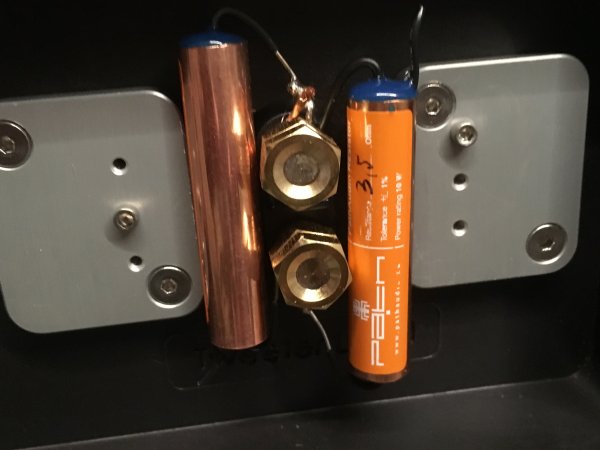zero interest in debating the armchair analysts. i'll just say debbie's statements ("refresh the sound") are IME highly credible and understated---if the resistors are worn (measure when cold) then its akin to changing old strings on a guitar to new ones. yes, it can be profound, ignore debbie at your choosing. she knows better than you about the speakers.
as a believer of both debbie and parts voicing (more in a sec) i swapped in path audio resistors for the caddocks in my sasha 2s.
2* 3.0r for the mids
1* 3.9 + 1.3.5 for the tweet (which should get 1.84r, vs 1.875r via caddocks)
on mounting, mids measured ~ 1.5-1.6 w/ my fluke, tweet measured 2.0-2.1. (not ideal--more in a sec)
path were the only ones that demonstrated sufficient power handling specs (duelund do but looks like they don't fit). trouble w/ path is they leads are about 0.5" too short to simply mount in place. so whereas its a 30min job to do both speakers w/ new caddocks, its a 4hr job as i had to solder on leads to one leg of each path resistor).
stupid path audio.
sonic impressions:
i recall bob crump (RIP) of TG Audio (and CTC, and also responsible for the 'voicing of the Parasound JC1) that caddocks were a sometimes part. --goes with the concept of voicing as you never hear a 'part' or a component, but a system in a room.
caddocks have a sonic signature (similar to what martin colloms wrote), and IIRC wilson has been using them throughout their products. a caddock would be the wrong part to voice an inverted dome (or in wadia, or esoteric) but has a good offsetting quality to the esotar tweeter (which is extended and sweet withouth reaching the netherheights of other ubertweeters out there). -itd also be a good part in modwright tube CD players if that makes sense.
but sometimes voicing around lesser parts is making the best meal possible with lesser ingredients. went through this years ago when i replaced the sand (!) resistors in the backplate of a $20K reference electrostatic speaker with a gazillion mills in parallel--it was a new speaker with new levels of realism and resolution. but sand is clearly < caddock. this test is simply caddock vs path in the sasha 2.
the path sound like better ingredients. --i've played a day on them (first 2 hours - YUK!), and now hearing more resolving mid & treble harmonics in eschenbach's mozart piano sonatas and holly bowling's dead covers (highly recommended). better front-back space, more percussive / dynamic, albeit with minor perceived loss of uppermost register (but this could be perceived: anyone who thought wadia or esoteric digital was extended found differently when faced with superior digital playback--ears take time to adjust. however, this could also be the slight variance from spec on the tweeter: 2.0 vs 1.875 as recommended. i dont know). its easier to unwind nuance in left hand action, and vocals (jim james w MMJ - acoustical circuital) that are close-miked have that n'th level of detail that audiophiles are always happy to find.
the prototypical complaints that wilson speakers *used* to have (amusical, respect not love, analytic) and which i heard straight thru Sasha gen 1 are the sorts of characteristics i would assign to caddocks. --now, you can voice around their use (ie ARC tube gear--somewhat mellow and round to offset wilson's analytic, with the analytic tilt in the wilsons via caddocks---calling it as i hear it), but if you were using SS gear without the tube sweetness (i'm using luxman C/M900 w/ audioquest wild speaker cables), then the notion of using a lesser part (caddock) with more neutral (?) upstream becomes a different tilt to the meal's flavor. like using too much spice when the ingredients are good enough to stand alone.
again, the path strike me as a better ingredient. certainly on the mids, the tweet i'm not entirely confident (how much is esotar / caddock voicing vs wrong measured value of path is impossible to know without further tests / spec matching).
anyone who has ever heard tonal differences between ac plugs or duplexes will immediately recognize the sound of the different brands of resistors in their speakers. anyone who can't hear such nuances, well, life is simple. ignorance is bliss.


